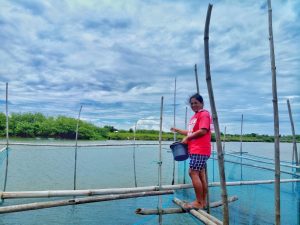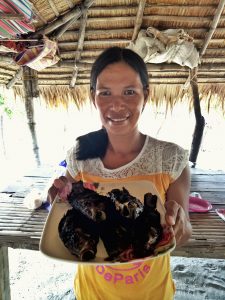
Apart from furniture making, San Vicente town in Ilocos Sur is also known for its Aquaculture industry. Most of the fish cages can be found in the barangays of San Sebastian and Pudoc. Although this livelihood has a high income potential, most of the Pantawid Pamilya beneficiaries in the area only get a stipend out of fish farming because they only work as tenant fishermen.
With the assistance from the Sustainable Livelihood Program (SLP) of the Department of Social Welfare and Development Field Office 1, 60 Pantawid Pamilya beneficiaries from the said barangays underwent a Skills Training on Tilapia Fish Culture and graduated on 31 October 2016. Each program participant was given an allotted budget of Php10,000.00 from the SLP Regular GAA 2016 Microenterprise Development fund, inclusive of training fees, meals and transportation allowance, complete fishing materials and tilapia fingerlings. The Local Government Unit of San Vicente provided the training venue.
The program participants were later organized into Agtignay Mangngalap Association creating their own rules and regulations. Divided into four groups, they were renting a total of 15 cages for Php500.00 each per year. With the unity and cooperation of the members, each of them received Php5,000.00 from their first harvest, plus their first Association’s saving.
Managing shocks

Too early to test the Association’s resiliency, a fish kill was experienced in the area due to environmental stress sometime in April and May this year. Applying what was taught in their training, the Association was saved from bankruptcy because they were able to detect the fish kill early, thus fresh tilapias were sold and dead tilapias that were still safe for human consumption were salted, dried and sold. “Imbes a malugi, nakaganansyakami pay laeng iti Php2,800.00 kada miembro. Dakkel a tulong talaga diay training (Instead of losing capital, we were still able to generate Php2,800.00 profit for each member. The training was really a great help),” said SLPA President Marjorie Ragunjan.
Building cages to building home
“Supsuportaran na kami dagiti assawami. Isoda pay iti agpakan dagiti sida no dadduma (We are getting support from our husbands. They sometimes feed the fish, too),” said Marjorie. She even shared that her family saved the profit she received out of tilapia farming and later utilized it to improve their house. From a one room bungalow, her family now has a small sala and kitchen.
Now, the Association is eyeing for a higher income that would sustain the arising needs of their families, particularly for the schooling of their children. It was agreed upon that the Association’s savings will be utilized to buy more fishing materials so they can produce higher yield. Having their own fish propagation cages is also part of their future plan. (by: Janine Joy B. Altero, Social Marketing Officer, Sustainable Livelihood Program)

